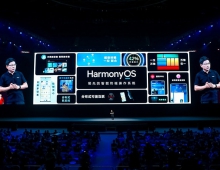
Huawei Says New Kirin 990 Mobile Chipset Is The World's Most Powerful
Huawei Technologies showcased the Kirin 990 chipset for a new high-end smartphone on Friday, pressing ahead with plans to launch its Mate 30 range, despite uncertainty about whether the new phones will be able to run Google’s Android operating system and apps.
The company claims that the Kirin 990 chipset is the first all-in-one 5G system on a chip, describing it as superior to alternatives from Qualcomm and Samsung that graft 5G modems on to 4G chips.
“It’s the world’s most powerful 5G system on a chip. It’s the world’s most powerful 5G modem,” Richard Yu, the head of Huawei’s consumer business group, said in a speech in Berlin.
The Kirin 990 is made using TSMC's latest 7+ manufacturing process with EUV and will power Mate 30 smartphone that will be unveiled on Sept. 19 in Munich.
It packs more than 10 billion transistors and can support downlink speeds of up to 2.3 gigabits per second. It has also an adaptive receiver that enables it to switch between 4G and 5G where coverage of the faster technology is weak.
Rather than offer a single solution to markets with 5G and 4G coverage, Huawei is splitting its strategy, with two versions of the Kirin 990.
These versions will officially be known as the Kirin 990 and the Kirin 990 5G. The two Kirin chipsets have the same core configuration, same camera support, same memory, same storage. However, in a few key areas beyond the modem, there are differences, such as NPU performance and core frequencies.
The Kirin 990 5G is supporting Sub-6 GHz 5G networks on both SA and NSA architectures.
Currenty, neither Qualcomm, nor Samsung have a unified flagship chip design that is near commercialization.
They feature two high frequency A76 cores, two medium frequency A76 cores, and four more efficient A55 cores. These are split into their own power and frequency domains, allowing better flexibility based on workload. However, the 990 5G and 990 4G will both have slightly different frequencies, based on the differences between the 7 and 7+ processes. For caches, the all four A76 cores have 512 kB L2, while the A55 cores are 128 kB each.
For the graphics, the Kirin 990 parts will both have a 16-core Mali-G76 implementation, up from a 10-core Mali-G76 in the Kirin 980. The performance of the GPU has increased, as we move from a 10-core 750 MHz design to a 16-core 700 MHz design.

Aside from implementing the 5G modem, the Kirin 990 packs a Neural Processing Unit (NPU).
The 990 5G will have two ‘big’ NPU cores, supporting dual ML processes concurrently, along with a Tiny Core NPU. The 990 4G will only have one ‘big’ NPU core, plus the Tiny Core.
| Kirin 990 5G |
Kirin 990 (4G) |
|
| CPU | 2xA76 @2.86G 2xA76 @2.36G 4xA55 @1.95G |
2xA76 @2.86G 2xA76 @2.09G 4xA55 @1.86G |
| GPU | G76MP16 @700M |
G76MP16 @700M |
| NPU | 2 + 1 Da Vinci |
1 + 1 Da Vinci |
| Modem | Balong 5G | 4G |
| DRAM | LPDDR4-4266 + LLC |
LPDDR4-4266 + LLC |
| Die Size | >100 mm2 | ~90 mm2 |
| Transistors | 10.3b | ~8.0b |
Huawei gave some performance numbers of the 990. The mantioned a +9% increase in single threaded performance from Kirin 980 to Kirin 990 5G, mostly driven through the higher frequency. Multithreaded performance overall was listed as being up 10%.
Huawei puts the AI performance of the Kirin 990 5G as 2.5x over the Kirin 980, and a similar amount over the Snapdragon S855 and Exynos 9825, as just under 2x compared to the Apple A12. Power efficiency is also improved by similar amounts. All this was comparing inference scores at both FP16 and INT8 quantization.
It is still not known whether the upcoming Huawei Mate 30 will be able to run services from Google following the blacklisting of the Chinese company by the U.S. administration in May. The services in doubt include pre-installing the Google Play store and a suite of popular apps such as Google Maps that buyers would expect to be available from the moment they turn on their new phone and synch it with their profile.
Huawei Technologies also announced an update to its P30 Pro smartphone and said it would run the latest version of Google’s Android software in some regions.
It’s the company’s first major update to a flagship phone since the imposition of U.S. export restrictions, which forced Huawei to slash projections for annual revenue at its consumer devices business by about $10 billion. Since the product is an update to an existing model, it may be able to ship with updated software from Google.
The phone will be available in two new colors when it goes on sale Sept. 20.
Huawei Consumer Chief Executive Officer Richard Yu didn’t say which territories would include the Android 10 operating system out of the box.
In addition, Huawei may start to sell its Mate X foldable phone as soon as next month, said CEO Richard Yu in a briefing at IFA on Friday.
Yu said he'd hoped the phone would be on sale already, but because of the rollout of 5G and the need to give app developers time to adapt their apps to the new screen size, it has taken longer than expected.
"Maybe next month we can start to sell it globally," he said on Friday. "The manufacturing of this phone is not only very expensive but has some challenges for volume and mass production." Yu said Huawei. It would be possible to do this as the chip is already commercially available, he said.
Unlike the Samsung galaxy Fold, which opens like a book to reveal a bendable screen on the inside, the Mate X has its screen curved around the exterior. This means you only need open it up when you want to fold out the full tablet-sized display, rather than every single time you use it.





















